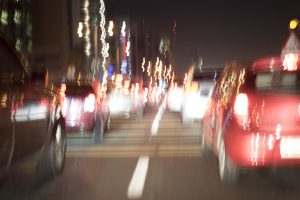 Drivers with cataracts and blurred vision pose a risk to pedestrians at night even if they have passed the standard vision test. The study found that cataracts and blurred vision severely reduce driver’s ability to recognize pedestrians – despite passing the driving test.
Drivers with cataracts and blurred vision pose a risk to pedestrians at night even if they have passed the standard vision test. The study found that cataracts and blurred vision severely reduce driver’s ability to recognize pedestrians – despite passing the driving test.
Study author Joanne Wood said, “Optical blur and cataracts are very common and lots of people with these conditions continue to drive. The aim of our study was to better understand how these visual conditions affect the ability to recognize and respond to roadside pedestrians at nighttime, and we also wanted to see if certain types of pedestrian clothing could improve the ability of a driver to recognize pedestrians at night, even when the driver had some level of visual loss.”
Advertisement
The study looked at 28 young drivers who met the minimum Australian licensing criteria of 20/40 vision or better to assess their ability to recognize pedestrians. The participants drove at night on a closed road course wearing simulated refractive blur and cataract lenses. Pedestrians wore different outfit options, namely, all black, black with a reflective vest, and all black with reflectors on the wrists, elbows, ankles, etc. Sixteen of the 28 drivers were asked to identify the pedestrian against the simulated headlight gear.
The study uncovered that cataracts are much more disruptive than blurred vision when attempting to spot a pedestrian. Drivers with simulated blurred vision were able to detect a pedestrian 52.1 percent of the time, while those with cataracts only recognized pedestrians 29.9 percent of the time. The pedestrians wearing the reflectors were the most easily detected, compared to those wearing all black. In fact, none of the participants with cataracts were able to spot a pedestrian in black clothes.
Wood concluded, “Future studies should further explore the impact of uncorrected refractive error, cataracts, and other forms of visual impairment on driving performance and safety, as well as determine the value of some relatively new ways to measure visual abilities, such as straylight testing and contrast sensitivity. It is possible that measuring only visual acuity does not provide us with the best way to determine who is safe to drive.”
Blurred vision cataracts and driving at night
There are many reasons why driving at night can become progressively challenging the older we get. For starters, the pupils’ ability to shrink in the dark and dilate gets reduced with aging, which means the retina receives less light, so the image appears blurry. The lens and cornea become less clear and contrast sensitivity – the ability to distinguish slight differences in brightness – decreases. Lastly, seniors are at a higher risk for many conditions that affect the eyes, including cataracts, glaucoma, diabetic retinopathy, and age-related macular degeneration, which can all impact the quality of vision.
Advertisement
Cataracts, in particular, affect driving in the following ways:
- Objects appear blurry
- Objects are difficult to see in bright lights such as headlights
- Headlight glare is intensified
- Colors appear faded
- Night vision is worsened
- Double vision may occur
All of these factors may increase the risk of road injury, that’s why the safety of driving with cataracts is often questioned. You should always check with your doctor to make sure the cataracts are not affecting your ability to operate a vehicle. Depending on the severity of your condition, your doctor may give you a green light to drive during the day, but recommend you to steer clear of driving after the sun sets.
To be on the safe side, try carpooling as much as possible, take public transit, or call a taxi when you need to head out.
